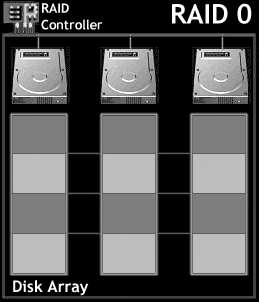Using several hard drives connected to a controller, the hard drive array can facilitate rapid reading and writing of data by separating data into consecutive blocks that are read or written to different physical drives in order.
Imagine writing the first 7 letters of the alphabet with 3 writing hands instead of one. If your brain was able to pre-sort the data so that hand one started on ‘d’ the second it finished ‘a’, and so on, you would theoretically have a write-rate three times faster than with one hand.
As a result, system performance improves tremendously because the data is spread out over X number of drives. Better performance will be observed as the physical disk-to-controller ratio approaches one.
This configuration is not truly a valid RAID implementation because it’s not fault-tolerant. If one drive fails in a RAID 0 array, then all of the data on the array is completely gone. If you have a RAID 0 implementation with 3 10GB drives, you’ve got three different points of failure that could trash 30 GB of data.
The major use of RAID 0 is that in striping data across disks, a input/output performance boost is seen. If you need speed and don’t care so much about redundancy, then RAID 0 is for you.
